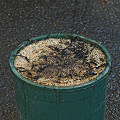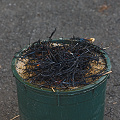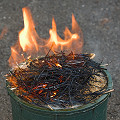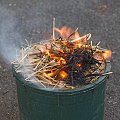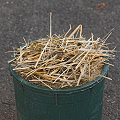Q: How do I stimulate seeds to germinate?
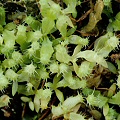
Nepenthes ventricosa

Sarracenia purpurea
seedlings

A bazillion
Dionaea seeds
A: Seeds from carnivorous plants are either easy to germinate, moderately
easy, or close to impossible! In most cases, prepare a pot with the same soil that would do well for
a mature plant. Sprinkle the seeds upon
the surface--do not bury them. Keep the pot moist and in bright conditions,
just as if it contained a growing carnivorous plant, and then
wait. Germination takes longer for carnivorous plants than for garden vegetables---if seeds
germinate within a few weeks, most veteran growers are pleasantly surprised.
Some carnivorous plants take months to germinate. When I sow seeds, I do not
give up on the pot until two years pass. Patience is the key word. Plant
the seeds, then try to forget about the pot---a watched pot never
germinates.
The seeds produced by tropical species are usually the fastest
and easiest to germinate. They may germinate within a few weeks after being shed from
the flower.
In contrast,
carnivorous plants which live in places that have real winters are harder
to convince to germinate. These seeds do not want to germinate
late in the fall only to be killed by the winter, so they
are looking for a signal to tell them that a winter has just
passed, and spring has arrived.
For example, seeds of Sarracenia (or those
Drosera and Pinguicula from lands
where snow falls each winter) must experience a cold spell before they will
germinate well. (The key word is well---some will germinate without a
cold treatment, but you will get much better results by providing the
treatments.) This cold treatment is called stratification.
During stratification, the seeds must be kept both cold and moist. (The seeds
need to absorb water to begin the germination process). I prefer to sow
such seed in their pots, and give them a wet, chilly winter just like the
mature plants get. In the spring, after a few months of cold, they start
erupting from the pots. It's quite exciting. (Sometimes the thrill is so
great I have to sit down and rest for a while.) About four weeks is the
optimal stratification time for most Sarracenia.
Shorter stratification periods will result in less complete germination.
Longer stratification periods for S. leucophylla
can result in smaller germination rates.
Some Sarracenia may do better with a stratification
of about six weeks; S. purpurea var.
venosa, S. purpurea subsp. purpurea,
and S. jonesii respond to this treatment by germinating
faster, although the same overall germination rate is ultimately the same.
Venus flytrap seeds are about 1.5 mm long, and look like shiny black bugs; they're
kind of creepy, actually (see the photo to the right). If you want to grow Venus flytraps from seed, you
should give them a cold, wet stratification period of four weeks just like I described above.
Venus flytrap plants grown from seed are less than a few cm (1 inch) across, even after
two years, so unless you really have a good reason to grow them from seed, stick with
vegetative propagation.
The seeds of some carnivorous plants are extremely
difficult to germinate. This includes those plants that live in seasonally
arid habitats, such as the tuberous and pygmy Drosera, Byblis,
and some Utricularia. These can be very annoying species which
require great heroism to germinate. They
may need special chemicals like giberellic acid. I don't want to be
responsible for your death, so I won't tell you more about this compound.
Other species require scarification (scratching or damaging the seed coat). It is often said that
Drosophyllum needs scarification to germinate, but I have
found that fresh seed germinate just fine without it.
Some carnivorous species are adapted to wildfires, and even expect that
an occasional fire will sweeping through
their habitats. Indeed, some of these species will not germinate if not exposed to certain
fire-related effects. It is probably the compounds released from burning, and not
the heat from the fire, that encourages germination.
Carnivorous plant growers may try to synthesize this
effect by lighting a small fire over their pots!
I'll let you work on that one
without my help---I don't want to be sued when you set your town on fire.
(Just a few hints: Use only natural fuels---no gasoline, don't set the pot
on fire, try for a "cool" burn, plant seeds at various depths
in the soil to improve the chances you'll get the correct temperatures the
seeds want, and water the pot after the fire to drive the
ashy compounds ito the soil. Do not light
indoors. Do it under adult supervision only, light fuse and get away.)
Some
people have started experimenting with smoke-infused pieces of paper, pellets,
or water to duplicate the chemicals associated with fires. To learn more about
this, do a web search using the key words "liquid smoke germination". Some even use a liquid smoke
flavoring you can buy in stores catering to folks who barbeque food!
Lastly, there are some seeds which just never seem to germinate! This is especially
the case for wild-collected seeds. (Seeds that were legally and ethically collected,
I assume...) Trying to grow species that are new to cultivation is a special thrill.
Quite often you are unsuccessful, and the seeds simply do not germinate. However,
when they do, it is often marvelous. Good luck finding the precise set of cues that
such seeds await!
Page citations: Ellison, A. 2001; Rice, B.A. 2006a; personal observation.
